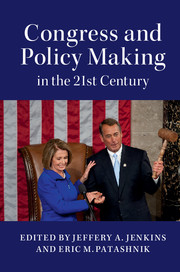Book contents
- Frontmatter
- Contents
- List of Figures
- List of Tables
- List of Contributors
- Acknowledgments
- 1 The Evolving Textbook Congress: Polarization and Policy Making on Capitol Hill in the 21st Century
- PART I CONGRESSIONAL POLICY MAKING IN A POLARIZED AGE
- PART II CONGRESS AND SOCIETY
- PART III CONGRESS AND ECONOMIC POLICY
- 6 Congress Makes Tax Policy: Democrats and Republicans at Two Critical Junctures
- 7 The Decline of Regular Order in Appropriations: Does It Matter?
- 8 Congress and the Federal Reserve: Independence and Accountability
- PART IV CONGRESS AND DOMESTIC POLICY DILEMMAS
- PART V REFLECTIONS
- Index
- References
7 - The Decline of Regular Order in Appropriations: Does It Matter?
from PART III - CONGRESS AND ECONOMIC POLICY
Published online by Cambridge University Press: 05 February 2016
- Frontmatter
- Contents
- List of Figures
- List of Tables
- List of Contributors
- Acknowledgments
- 1 The Evolving Textbook Congress: Polarization and Policy Making on Capitol Hill in the 21st Century
- PART I CONGRESSIONAL POLICY MAKING IN A POLARIZED AGE
- PART II CONGRESS AND SOCIETY
- PART III CONGRESS AND ECONOMIC POLICY
- 6 Congress Makes Tax Policy: Democrats and Republicans at Two Critical Junctures
- 7 The Decline of Regular Order in Appropriations: Does It Matter?
- 8 Congress and the Federal Reserve: Independence and Accountability
- PART IV CONGRESS AND DOMESTIC POLICY DILEMMAS
- PART V REFLECTIONS
- Index
- References
Summary
INTRODUCTION
Political scientists often teach an idealized version of the congressional budget and appropriation process known as the “Regular Order.” As codified in the Congressional Budget and Impoundment Control Act of 1974, budgeting and appropriating should unfold in a very precise way. The president initiates the process by presenting a budget request for the following fiscal year on or before the first Monday in February. The action then moves to Congress where the House and Senate pass budget resolutions that contain spending allocations, known as 302(a), for each appropriation jurisdiction. According to the textbook, the House and Senate then use a conference committee to iron out any cross-chamber differences. Following the passage of the budget resolution, appropriation committees formulate 302(b) suballocations for each subcommittee that then produces its own appropriation bill. These proposals come to floor as individual bills that contain only appropriations. Any House–Senate differences in their respective appropriation bills are ironed out in conference. After conference reports are passed, the president signs them into law well before the beginning of the fiscal year on October 1.
But over the past several years, the process is best described as the “Regular Disorder.” The president often misses the early February target for his budget request. With increasing frequency, the House and Senate fail to pass a budget resolution. Even when both chambers pass budget resolutions, conference committees are rarely convened so the differences between the two resolutions are never reconciled. Over the past decade, very few appropriations bills have passed before the beginning of the fiscal year. More commonly, governmental activities are funded for many months through continuing resolutions (CRs). Occasionally, all federal spending for an entire year is provided under CRs. When appropriation bills do pass, they are often packaged together as omnibus bills that are negotiated by party leaders and the president, thus circumventing the role of the appropriation committees. These omnibus bills have increasingly become vehicles for legislative initiatives unrelated to appropriations.
In this chapter, I examine trends in what I will call the procedural fiscal performance of Congress and the president. In doing so, I evaluate several hypotheses about why the regular order in Congressional budgeting and appropriations has fallen into disuse. While the question has many angles and dimensions, I consider three aspects.
Information
- Type
- Chapter
- Information
- Congress and Policy Making in the 21st Century , pp. 162 - 186Publisher: Cambridge University PressPrint publication year: 2016
References
Accessibility standard: Unknown
Why this information is here
This section outlines the accessibility features of this content - including support for screen readers, full keyboard navigation and high-contrast display options. This may not be relevant for you.Accessibility Information
- 1
- Cited by
